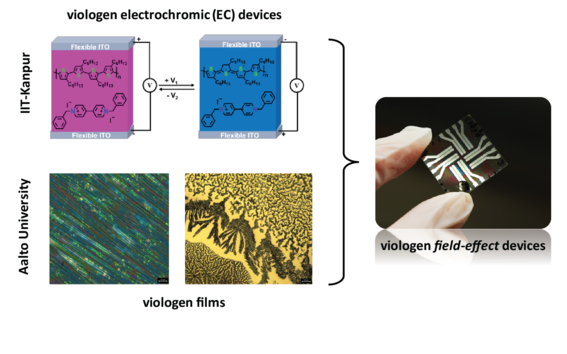Developing of Flexible Viologen-based Electrochromic Devices

Viologens, organic redox active materials capable of reversible redox behavior, have emerged as promising candidates for EC applications due to their ability to modulate reversible optical properties in response to an applied bias. By synthesizing viologen derivatives and integrating them between two flexible ITO electrodes, the research seeks to fabricate low-cost, high-performance EC devices. The research project is spearheaded by Dr. Caterina Soldano - Aalto University, and in collaboration with Dr. Prakash Chandra Mondal - IIT-K.
The scientific background of the project underscores the growing interest in organic materials and devices as potential solutions for various applications, including wearable and flexible electronics, bio-sensing, display architectures, and lighting. Viologens, with their distinct color changes upon reduction, offer a pathway toward developing efficient and customizable EC devices. The objectives of the research include synthesizing and characterizing electroactive viologens, fabricating nanoscale films of electrochromic materials on flexible substrates, and electrical characterization of resulting devices.
The collaboration between Aalto University and IIT-Kanpur brings together expertise in device fabrication and viologen compound synthesis, respectively, to address the challenges associated with flexible EC device fabrication. The project aims to generate data for future joint grant applications, publish findings in high-impact forums, and present results at national and international conferences. Additionally, researcher training and outreach activities are planned to engage the scientific community and the general public alike. According to Dr. Soldano, the project will have a significant impact on both the scientific and technological communities, aligning with Aalto University's strategic efforts in photonics research and innovation. Furthermore, the collaboration between Aalto University and IIT-Kanpur is expected to pave the way for long-term partnerships in the development of organic optoelectronic devices.
For more information and updates on the project's progress, visit the Organic Electronics group's website.
